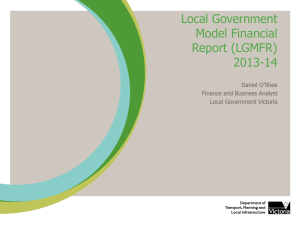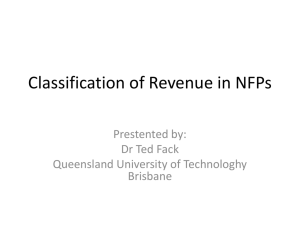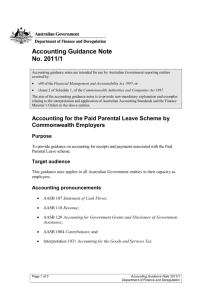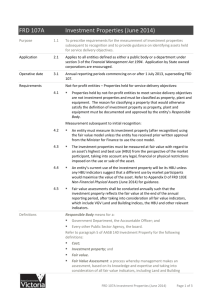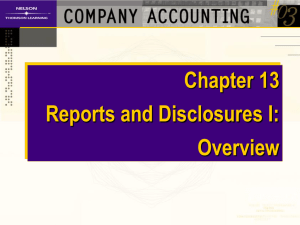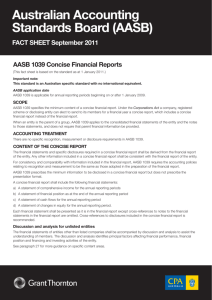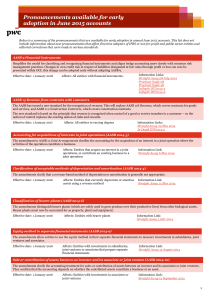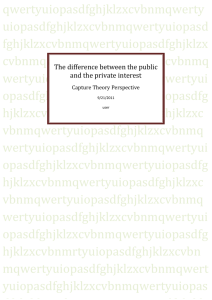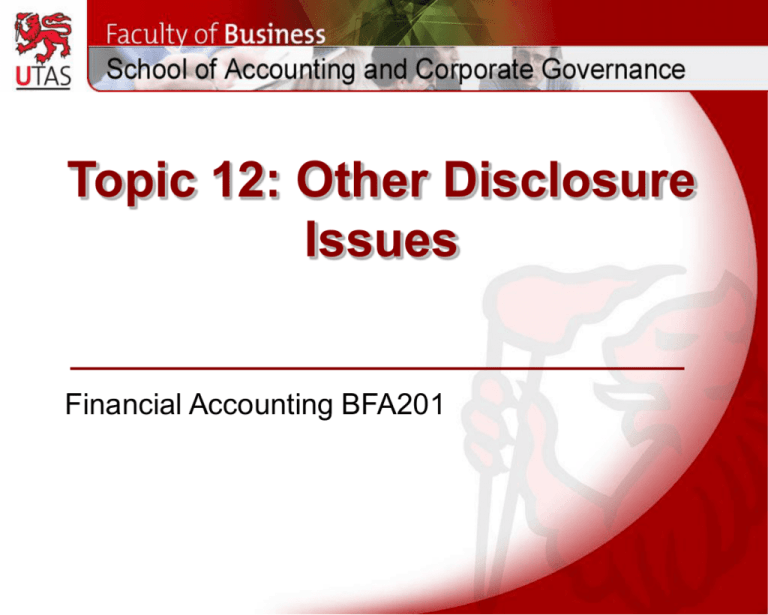
Topic 12: Other Disclosure
Issues
Financial Accounting BFA201
Readings and References
• Deegan Chapters 23 and 35
• AASB 101 Presentation of Financial Statements
• AASB 110 Events After the Balance Sheet Date
• AASB 1031 Materiality
2
Independent Study Tasks
Tutorial questions (for workbooks)
• Tutorial Question 1 Deegan 7th ed, Ch. 23, Challenging Question 6 (p.
791)
• Tutorial Question 2 Deegan 7th ed, Ch. 23, Challenging Question 8 (p.
792)
• Tutorial Question 3: Deegan 7th ed, Ch. 35, Review Question 26 (p.
1268)
• Tutorial Question 4: Deegan 7th ed, Ch. 35, Review Question 30 (p.
1269)
• Tutorial Question 5: Deegan 7th ed, Ch. 35, Challenging Question 38
(p. 1270)
Independent study questions
• Chapter 23 – Review Question 2
• Chapter 23 – Review Question 3
• Chapter 35 - Review Question 3
• Chapter 35 – Review Question 13
Learning Objectives
• Understand the nature of events occurring after the balance
date & apply the requirements of AASB 110 ‘Events after the
Balance Sheet Date’ in the preparation of financial reports
• Understand the concept of materiality & apply the requirements
of AASB 1031 ‘Materiality’ in the preparation of financial
reports
• Also looking at:
– Corporate social responsibility
– Assess the role of corporate social responsibilities in the
context of the corporate objective of maximising
shareholders’ wealth
– Identify reasons for the voluntary disclosure of information
on corporate social responsibilities
– How does the Framework relate to CSR?
Disclosure issues
in financial reporting considered
• Events occurring after balance date
• Materiality (re-visit)
• Corporate Social Responsibility
• Corporate Governance
5
Introduction
•
AASB 101:9 provides information about the
purpose of financial statements:
•
Financial statements are a structured representation
of the financial position and financial performance of
an entity
•
The objective is to provide information about the
financial position, financial performance and cash
flow of an entity that is useful to a wide range of
users in making economic decisions.
•
Financial statements also show the results of the
management’s stewardship of the resources
entrusted to it.
Introduction
•
AASB 101:7 defines ‘general purpose financial
statements’ as:
• Are those intended to meet the needs of users
who are not in a position to require an entity to
prepare reports tailored to their particular
information needs.
•
AASB 101:Aus7.2 defines a reporting entity as:
• An entity in respect of which it is reasonable to
expect the existence of users who rely on the
entity’s general purpose financial statement for
information that will be useful to them for making
and evaluating decisions about the allocation of
resources.
Introduction
•
AASB 101:10 indicates that a complete set of
financial statements comprises:
•
•
•
•
•
•
A statement of financial position;
A statement of comprehensive income;
A statement of changes in equity;
A statement of cash flows for the period;
Notes, comprising a summary of significant
accounting policies and other explanatory
information; and
And (see f)
Introduction
•
AASB 101 does not prescribe which entities
must prepare general purpose financial
statements
•
These requirements stem from the Corporations
Act (Part 2M)
•
S. 292 (1) requires that all disclosing entities, all
public companies, all large proprietary
companies, and all registered schemes prepare
a financial report and a directors’ report for each
financial year.
Introduction
•
S 295 (1) indicates that the financial report for a
financial year consists of:
• The financial statements for the year; and
• The notes to the financial statements; and
• The directors’ declaration about the
statements and notes.
•
S 295 (2) indicates that the financial statements
for the year are the financial statements that are
required by the accounting standards.
•
See a previous slide for AASB 101:10
Introduction
•
S 296 (1) indicates that the financial report for a
financial year must comply with the accounting
standards
•
Although there are reduced requirements for
what are referred to as ‘small proprietary
companies’
Introduction
•
S 297 requires that the financial statements and notes for a
financial year must give a true and fair view of the financial
position and performance of the company, registered scheme
or disclosing entity.
•
However, the concept of ‘true and fair’ is not defined by the Act
nor are the concepts of ‘true and fair’ and ‘present fairly’ dealt
with directly in the AASB Framework.
•
However, paragraph 46 of the AASB Framework indicates that
the application of the qualitative characteristics and appropriate
accounting standards normally results in financial reports that
convey what is generally understood as a true and fair view.
•
Non-compliance is allowed if management concludes that
compliance does not provide a “true & fair view”
•
AASB 101 requires detailed additional disclosures in such
circumstances outlining the reasons etc for the departure
Annual Directors’ Report
•
S 298 requires that the company must prepare a
directors’ report for each financial year.
• Two main parts:
– General management discussion including:
• Review of operations and results thereof
• Details of significant changes during the year or
after reporting date
• Likely future developments
• Entity’s performance in environmental regulations
– Specific information:
• Information about dividends, directors, options
and indemnities, unissued shares
Annual Auditors’ Report
The auditor must form an opinion as to whether the:
• financial report is in accordance with Corporations Act
and AASB accounting standards
• Financial report gives a true and fair view
• auditor has been given all necessary information and
explanations
• company has kept financial records to enable a
financial report to be prepared and audited
• company has kept registers and records required by
the Corporations Act
Concise Financial Reports
• Under S. 314 instead of sending each member a full
set of financial statements and notes, the directors’
report and the auditors’ report, a company has the right
to send a concise report for the financial year.
• The content of these is governed by AASB 1039
Concise Financial Reports.
Concise Financial Reports
• Under the Act, the concise report should consist of:
– Concise financial report in accordance with accounting
standards
– Directors’ report for the year
– Statement by the auditor:
• That the financial report has been audited
• Whether, in the auditor’s opinion, the concise financial
report complies with accounting standards
– Other contents of the concise final report are:
• A copy of any qualification and any emphasis of matter in
the auditor’s report.
• A statement that the report is a concise financial report
and that the full financial report and auditor’s report will be
sent free of charge.
Concise Financial Reports
• Under AASB 1039, the following must be included in
the concise report:
–
–
–
–
–
A statement of comprehensive income
A statement of financial position
A statement of cash flows
A statement of changes in equity
Management discussion and analysis
Concise Financial Reports
• Why are concise financial reports allowed? Financial
reports are overly technical and complex.
• Concise financial reports:
–
–
–
–
Easier to read and understand
Better public relations
Cost savings
Dramatic increases in share ownership
• On average, firms that produce concise financial
reports are:
– Larger
– More profitable
– Have a higher percentage of smaller shareholders
Interim Reporting and Continuous
Reporting
• Two major limitations of annual reporting are:
– Information is often out-dated by the time it is published;
– Intra-year trends are difficult to discern
•
Disclosing entities are required to produce a half year
financial report. These are governed by AASB 134 Interim
Financial Reports
–
–
–
Set of half year financial statements;
Notes to the financial statements;
Directors’ declaration about the notes and the financial
statements
• ASX Listing Rule 3.1 requires that listed companies must
immediately notify the ASX of any information concerning it
that a reasonable person would expect to have a material
effect on the price of the entity’s securities.
General Features of Financial Reports
• AASB 101 sets out seven overall considerations that need to
be adhered to in the presentation of financial statements:
1
2
3
4
5
6
7
• Fair presentation
• Compliance with IFRS
• Going concern
• Accrual basis
• Materiality and Aggregation
• Offsetting
• Frequency
• Comparative
General Features of Financial Reports
• AASB 101 sets out seven overall considerations
(CALLED GENERAL FEATURES) that need to be
adhered to in the presentation of financial statements:
• Fair presentation and compliance with IFRS (para.
15) – faithful representation of effects of
transactions and other events; state complying
• Going concern (para. 25) – when preparing
financial statements need to assess ability to
continue as going concern - disclose
• Accrual basis of accounting (para. 27) – financial
statements except cash flow prepared on accrual
basis
General Features of Financial Reports
•
•
•
•
•
Materiality and aggregation (para. 29) – each material
class of similar items presented separately. Can
aggregate if immaterial.
Offsetting (para. 32) – do not offset assets and
liabilities or income and expenses unless required or
permitted in an accounting standard
Frequency of Reporting (para. 36) – at least annually
Comparative Information (para. 38) – must present as
minimum 2 statements of financial position and other
statements
Consistency of Presentation (para. 45) – retain
presentation and classification of items from one
period to next
AASB 108 Accounting Policies,
Changes in Accounting Estimates,
and Errors
Accounting Policies
• Accounting policies are the principles, bases or rules
adopted by a company in preparing and presenting its
financial reports
• Policies apply to both initial recognition
of items and subsequent accounting for such items
• The major purpose of accounting standards is:
– Reduce the choice of accounting policies;
– To limit the opportunities fro creative accounting
• However, it is unlikely that the existence of accounting
standards will eliminate these opportunities because:
– It is impossible to prepare a standard for every topic;
– Many standards rely on judgement
• The argument for disclosure of accounting policies chosen
is so users can allow for them in making comparisons
Accounting Policies
• AASB 108 is the accounting standard which deals with:
– Setting accounting policies
– Changing accounting policies
– Disclosures in the financial statements concerning
accounting policies
• Accounting policies may be:
– Prescribed by law
– Mandated by accounting standards
– Based on ‘normal’ practice, or
– Specifically adopted by a company
• In selecting between competing policies regulators,
standard setters and management should consider the
relevance and reliability of the financial information
provided
Relevant information
• size or nature (material)
• timely and understandable
26
Relevant Information
• Relevant information (AASB Framework Paragraph 6)
is that which enables users to:
• Make predictions or form expectations about the
future performance of an entity;
• Confirm or refute past evaluations;
• Assess the accountability rendered by the preparers
of the financial statements.
• Information may be relevant due to its size or nature
• To be relevant, information must be timely and
understandable
Reliable Information
• Reliable information is that which is:
• Free from material error;
• Can be depended upon by users to represent
faithfully that which it purports to represent;
• In order to represent faithfully a transaction, it is
necessary that the substance of the transaction be
presented, rather than its legal form.
• E.g. Recognising an asset and corresponding
liability when accounting for a finance lease.
• Reliable information is:
• Neutral – free from bias
• Prudent – prepared using a degree of caution
• Complete – free from material error
Accounting Policies
A summary of accounting policies must be presented in
the initial section of the notes to the financial report under
AASB 108. The summary must:
Include:
A statement
about :
- GPFR
- Framework
used
- Accounting
standards and
interpretations
Disclose:
The
measurement
basis used in
preparing the
financial
report.
For example,
historic cost
except for
certain assets
at fair value.
Provide:
A description
of other
accounting
policies
e.g.
Measurement
of inventories
Disclose:
Judgements
apart from
those
involving
estimations
Accounting Policies
• Accounting methods are the ways that
accounting policies are applied.
• If the policy is that non-current assets are
depreciated annually, then the method is the way
the depreciation is calculated (e.g. Reducing
balance or straight line);
Accounting Policies
• Accounting policies can only be changed in the following
circumstances (AASB 101:14):
Required by an Australian
Accounting Standard
Results in financial statements
providing reliable and more
relevant information
The entity shall account for the
change in accordance with the
transitional provisions set out in
that standard
Voluntary changes are applied
retrospectively
Where no transitional provisions
are set out, the change must be
applied retrospectively (as if the
new policy had always applied)
• In such cases the entity is required to apply the new policy
prospectively from the start of the earliest period practicable.
• Detailed disclosures are required
Changing Accounting Estimates
• Changes in accounting estimates are covered by AASB
108:32 – 38
• Accounting estimates are regularly changed as new
information arises.
• Changes in accounting estimates require prospective
application
• Example: the useful life assessment of non-current assets
change due to technological advancements (i.e. The actual
useful life is shorter than the original estimate of useful life. In
such cases, the depreciation expense recognised in prior
periods is not changed, but the remaining carrying amount of
the asset is written off over its remaining (shorter) useful life
• Disclosures required when changing an accounting estimate
are contained in illustrative example 10.2
Correcting Errors
• Corrections of prior period errors are covered in AASB 108:
41-49
• Errors may arise as a result of a mathematical error,
misinterpretation of information, mistakes in applying
accounting policies or fraud
• Discovered errors (where material) must be corrected
retrospectively by:
– Restating the comparative amount in the prior period; or
– If the errors occurred before the earliest prior period presented, restating
the opening balances.
– Note the impracticality override contained paragraphs 43 to 48
• Disclosures required when accounting for an error are
contained in illustrative example 10.3
AASB 1031 Materiality
Materiality
S
i
z
e
AASB 1031
Omission
or
misstatement
&
N
a
t
u
r
e
Influence
decisions?
affect
accountability?
BFA201_13
Yes - Material
No – NOT Material
Yes - Material
No – NOT Material
35
Materiality
• The concept of ‘true and fair’ reporting does not
mean absolutely complete and accurate, rather,
it implies that reports are reasonably correct
• Thus, some errors and omissions may occur
without rendering the reports misleading
• All accounting information is assessed against
the concept of materiality
• Immaterial errors may not be corrected, or
immaterial facts may not be reported
Materiality
• AASB 1031:9 states that:
• Information is material if its omission,
misstatement or non-disclosure could
adversely affect users’ decisions or
management’s discharge of its accountability
• Materiality assessments require judgement and
apply to both the nature and amounts of
misstatements
• AASB 1031, provides guidelines to help
determine whether the amount of an item is
material
Materiality
• The assessment of information’s materiality is
(Framework):
Whether its omission or misstatement could influence
the economic decisions of users
• AASB 1031 para 9 states that:
Information is material if its omission, misstatement or
non-disclosure has the potential, individually or
collectively to:
Influence users’ economic decisions of users taken on
the basis of the financial statements; OR
Affect the discharge of accountability by the
management or governing body of the entity
• In deciding whether an item is material, its size and
nature need to be evaluated together
Materiality Guidelines – AASB 1031
1. Select base measure
2. Calculate % of
error
<
5%
Professional
NOT material
judgement
>
10%
MATERIAL
Materiality
Process:
•
1.
Select appropriate base amount
2.
Calculate error/omission amount as a
percentage of the base
3.
If error/omission is greater than 10% of base =
material
If error/omission is less than 5% of base =
immaterial
If between 5 and 10% – apply judgement
Remember these are ‘guidelines’ only and are no
substitute for professional judgement
AASB 110 Events After Reporting
Date
Events After Reporting Date
• In the period between reporting date and the date the
financial statements are authorised for issue, new
information often becomes available that provides
additional evidence of conditions that existed at
reporting date, or reveals for the first time a condition
that existed at reporting date
• such new information must be reflected in the financial
statements
• Financial statements are often not released for over 10
weeks after reporting date, and that to make them
more ‘relevant’ it is sometimes appropriate to add
notes giving additional information about material
events that have occurred since the reporting date
Events after reporting date
Example TIMELINE for issuing financial reports:
31 Aug
Reporting
Date
Draft
Report
18 Sept 19 Sept
Authorised
for issue
Profit
Announcement
30 June
1 Oct
Available to
shareholders
15 Nov
17 Nov
Approved Filed
at sharewith
holder
ASIC
meeting
43
Events after Reporting Date
AASB 110 defines an after reporting date event as:
• Those events, favourable and unfavourable, that occur
between the end of the reporting period and the date
when the financial statements are authorised for issue.
•
Such information or event must be
• material, and
• provide a clearer picture of the company’s situation
at reporting date or since
•
The standard requires action with respect to such events in
the interests of more relevant and reliable reporting
Events after Reporting Date
Events can be classified as:
Adjusting: those which provide more information
about conditions that existed at reporting date
For example – settlement of a law suit which had been
in process at reporting date
Non-adjusting: those which do not relate to conditions
existing at reporting date but which are material to an
evaluation of the reports prepared at that date
For example – an uninsured flood which destroys the
company’s manufacturing plant
45
Events after Reporting Date
AASB 110 requires that:
– An adjustment to the financial statements must
be made for Type 1 events
– Information about Type 2 events must be
disclosed in the notes attached to the financial
statements
Two Types of Subsequent Events
Adjusting
Event
Test for
Materiality
Nonadjusting
event
Existing
conditions
NEW
conditions
Adjust financial report
Disclose in Notes
Events after Reporting Date: Process
1
2
• Identify events
• Test for materiality
3
• Classify type: adjusting or nonadjusting
4
• Prepare adjusting journal entry
or note.
Lecture Case Study
The reporting date of Krasky Ltd is 30 June 2013. The following
events have taken place since reporting date:
•
•
•
•
On 17 July 2013, the company settled and paid a personal
injury claim from a former employee arising out of an
accident that occurred in September 2012. Damages
amounted to $65,000.
On 31 August 2013, a building owned by the company was
severely damaged by storm resulting in uninsured
damages of $150,000.
On 17 September 2013, the company issued 20,000 fully
paid shares ($1.50 each) to acquire net assets of Brass
Ltd.
All events are deemed material by nature and/or amount.
State whether each event would be an adjusting or nonadjusting event for Krasky Ltd according to AASB 110.
49
Solution
30 June
2013
Compensation Expenses
Claims payable
65,000
65,000
Being damages payable under injury
claim to former employee
NOTE X. Non-adjusting events after reporting date
On 31 August 2013, a storm severely damaged a
building owned by the company. Uninsured damages
amounted to $150,000.
On 17 September 2013, the company issued 20,000
fully paid shares at an issue price of $1.50 each to
acquire the net assets of Brass Ltd.
50
Other Disclosure Issues:
- Corporate Social Responsibility
- Social & environmental
accounting
- Corporate Governance
Corporate Social Responsibility
(CSR)
• …“the responsibility of enterprises for their impacts on
society”. To fully meet their social responsibility,
enterprises “should have in place a process to
integrate social, environmental, ethical human rights
and consumer concerns into their business operations
and core strategy in close collaboration with their
stakeholders” (EU, 2011)
• Corporate social responsibility reporting is the
information provided by the organisation on how it
addresses its corporate social responsibilities.
52
Social, environmental and triple-bottomline reporting
• Financial accounting is heavily regulated
• Social and Environmental disclosures are largely
voluntary
53
Social, environmental and triple-bottomline reporting
• Social reporting
• provides information about an organisation’s interaction with,
and associated impacts on, particular societies
• Environmental reporting
• is the communication of environmental performance
information by an organisation to its stakeholders
• Triple-bottom-line reporting provides information about:
• economic,
• environmental and
• social performance of an entity
54
Social, environmental and triple-bottomline reporting
• Triple-bottom-line reporting remains vountary.
• Entities often exclude information that portrays them in a
negative light.
• Sustainability
•
•
Need to consider whether a responsibility is owed to future
generations
Meet the needs of the present without compromising future
generations.
55
Accountability
• If an organisation is focused on profits alone
(using the accounting standards and Framework)
then spending money on looking after social or
environmental considerations is problematic.
• If an organisation does not have a responsibility
for an aspect of its performance, it would not be
expected to be held accountable for it.
• Accountability: responsibility to undertake certain
actions (or refrain) and responsibility to provide
an account for those actions
56
Accountability
• Differing views of business responsibility:
– Friedman’s view is that a business is established to
make a profit and therefore everything should be
focused on that.
– An alternative view is that the business should be for
the benefit of all stakeholders, not just finance
providers (shareholders, investors)
• If we accept entity has a responsibility for its social and
environmental performance accountants should
provide an account of social and environmental
performance. Consider social licence which contributed
to Gunn’s demise.
57
Links between CSR and Shareholder value
There are a number of reasons why social and environmental
performance can affect financial performance:
•
Consideration of social licence - organisations to contribute
to society and not harm environment, otherwise can lose
customer, employee, and community support. This
means it is difficult to get financiers (which was Gunns
problem).
•
Poor environmental performance can impact directly on
various corporate assets, e.g. pollutants on land
•
Social and environmental credibility can impact on value of
intangible assets (e.g. positive corporate reputation)
•
Individuals and governments increasingly likely to take legal
action against organisations that damage the environment
•
Increase in insurance costs to fund clean-ups, etc.
58
Links between CSR and Shareholder value
Figure 35.3 Deegan p. 1258
59
Stakeholder
Theory
Forestalling
other
regulation
Positive
Accounting
Theory
Motivations
for social and
environmental
reporting
Belief
managers
accountable
Legitimacy
Theory
60
Motivations for social and environmental
reporting
1. Influence the perceived legitimacy of the organisation –
social contract
2. Manage particular stakeholder groups – various
stakeholders considered important
3. Increase wealth of shareholders and managers of the
organisation
4. Belief on the part of managers that the entity has an
accountability to provide information
5. To forestall efforts to introduce more onerous disclosure
61
regulations
Gulf of Mexico oil spill
• 20/4/10: Explosion on BP’s Deepwater Horizon rig, 80
km off the Louisiana U.S.
• Kills 11 workers
• Millions of litres of oil spilt
• Hundreds of miles of coastline damaged
• 2010 BP annual report; cost $41b
– Spill response cost $10b (+1b provision)
• Ongoing costs; fines; litigation; reputation?
• Full Eco-impact unclear
• Fishermen – livelihoods destroyed
• Gov. report finds cause -“bad management”
62
Source: http://www.abc.net.au/news/photos/#num=14&id=2890475
BFA201_13
63
Source: http://www.abc.net.au/news/photos/#id=2890475&num=0
BFA201_13
64
Africa's oil spills are far from U.S. media
glare
• 18 May 2010
• LONDON (Reuters) - Oil gushing from an undersea well
in the Gulf of Mexico has damaged BP's reputation and
share price but accidents involving other companies in
less scrutinized parts of the world have avoided the
media glare.
65
Limitations of traditional financial
accounting and AASB Framework
• Financial accounting ignores many of the ‘externalities’
caused by reporting entities.
• Accounting standards and the AASB Framework dictate
the contents of the annual report.
• Clearly these standards and the AASB Framework have
limitations when it comes to requiring organisations to be
accountable for their social and environmental
performance.
66
Information
needs of
stakeholders
with financial
interest
Issues of
control and
measurement
Entity
assumption
Materiality
Limitations of
traditional
financial
accounting
and the AASB
Framework
Liabilities
discounted
67
Limitations of traditional financial
accounting and AASB Framework
• Focuses on information needs of stakeholders with a
financial interest
– This is reflected in the AASB Framework’s objective of general
purpose financial reporting.
• ‘Materiality’
– precludes reporting of social and environmental information —
difficult to quantify costs
• Liabilities often discounted to present value, future cleanup expenditures appear trivial because of this.
68
Limitations of traditional financial
accounting and AASB Framework
• Adopts the entity assumption
– where the entity is treated as distinct from its owners and
other stakeholders
– transactions not directly impacting the entity are ignored
– ignores externalities caused by the reporting entity, some
relating to social and environmental implications of the
entity’s operations
• Issues of control and measurement
– expenses are defined to exclude the recognition of any
impacts on resources not controlled by the entity
– externalities caused by the entity cannot be reliably
measured, and so are not recognised
69
CSR Reporting
•
•
•
•
•
Number of reporting guidelines have been released internationally
regarding environmental and, to more limited extent, social and
sustainability
To date no conceptual framework exists for environmental reporting;
disclosure based on perceptions of information needs of particular
stakeholder groups
Disclosure of social and environmental information often based on
reports that have been acknowledged as representing ‘best practice’, i.e.
they have been recognised by an award
Example: ACCA UK Sustainability Reporting Awards—recognise
organisations that are attempting to report on their triple bottom line
(economic, environmental and social performance)
Mining companies led the way in producing stand-alone social and
environmental reports and ‘sustainability’ reports
•
Organisations in other industries following the lead: Electricity,
Manufacturing, Water industries
•
Companies also often produce additional pages of information within their
annual reports on social and environmental performance
70
Safety doesn’t
sell cars!
• Ford Pinto: for 7 years (over 500 deaths) from
fuel tanks exploding after rear-end collisions
• Cost-benefit analysis: 1 life = $200,000
• $11 cost for improvement, not viable (damage
automotive industry)
71
Ok Tedi mining
disaster
• BHP mined for copper and gold in Papua New
Guinea
• Ok Tedi contributed 10% of GDP
• By 1990s waste clogged waterways destroying
forest, killing fish, inundating villages and
vegetable patches
• Acid rock drainage continues to pollute
72
Corporate governance
• The system by which companies are directed
and controlled
– objectives
– risk management
– performance
• ASX Corporate governance principles and
recommendations:
73
Corporate governance
Listed entities should:
establish and disclose the respective roles and responsibilities of
board and management.
have a board of an effective composition, size and commitment to
adequately discharge its responsibilities and duties.
actively promote ethical and responsible decision-making.
have a structure to independently verify and safeguard the integrity
of their financial reporting.
promote timely and balanced disclosure of all material matters
concerning the entity.
respect the rights of security holders and facilitate the effective
exercise of those rights.
establish a sound system of risk oversight and management and
internal control.
ensure that the level and composition of remuneration is sufficient
and reasonable and that its relationship to performance is clear.
74
Corporate Collapses
• Systematic failures:
• Corporate governance deficiencies
• Accounting deficiencies
Significant impacts on:
– Customers
– Suppliers
– Shareholders
– Employees
– Policy holders
75
Next Week –
Revision
Copyright notice
© Copyright University of Tasmania, School of Accounting & Corporate
Governance
All rights reserved.
Commonwealth of Australia Copyright Regulations 1969 - WARNING
This material has been reproduced and communicated to you by or on behalf of the University
of Tasmania pursuant to Part VB of the Copyright Act 1968 (the Act). The material in this
communication may be subject to copyright under the Act. Any further reproduction or
communication of this material by you may be the subject of copyright protection under the Act.
Do not remove this notice.
76

